
Today, we give you a few reasons why multi-purposeful MLB stadiums overstayed their welcome and eventually were phased out.
What can be said about the era of the multi-purpose facilities that has not been said before? Once deemed a spectacle, the cookie-cutter stadium was cost-efficient, while housing multiple events and teams from different sports. MLB Owners were looking for quick and easy access with a quick turn around.
Eventually, cookie-cutter stadiums are all, but obsolete as the Oakland A’s will be the sole owner of RingCentral Coliseum.
More from Call to the Pen
- Philadelphia Phillies, ready for a stretch run, bomb St. Louis Cardinals
- Philadelphia Phillies: The 4 players on the franchise’s Mount Rushmore
- Boston Red Sox fans should be upset over Mookie Betts’ comment
- Analyzing the Boston Red Sox trade for Dave Henderson and Spike Owen
- 2023 MLB postseason likely to have a strange look without Yankees, Red Sox, Cardinals
Astro-Turf
The year was 1965, and the Houston Astros were moving into a massive multi-facilitated stadium known as the Astrodome. Grass did not last for long as a mishap led to the birth of the Astro-Turf.
The greenhouse inspired Lucite panels spanned the roof, but proved to be an issue when the Astros players were losing flyballs against the sunlight. As a result, the organization decided to paint the roof black and thus leading to the grass to die.
In 1966, Astro-Turf as it was coined by the re-brand took and the rest was history. The Astrodome was the predecessor of many cookie-cutter stadiums that would follow in the same spirit of hosting baseball and football as well as any other gatherings that were needed.
The Dark Side of Astro-Turf
On paper, fake grass with little to no maintenance and could be picked up and replaced with dirt for the next event the following day or night. That’s well and good, but at the end of the day, you’re running on a concrete floor and artificial grass.
The product subsequently took a massive toll on athletes’ legs, ankles, and potentially career-ending injuries such as turf toe and concussions took their toll.
Another reason why the turf was looked down upon is because of the impact of the ball movement in the game. Unlike grass, the ball gave a faster bounce and allowed for more base stealing.
Lack Of Charm
Dual Use Facilities painfully took away the quaint and intimate style for the fan experience. Football stadiums and Baseball Parks have different dimensions especially when it comes to viewpoints and how close you can be to the action.
Rectangles paired with awkward and sometimes non-uniform dimensions of baseball will never mix beautifully. The consequence is a fanbase with a stale atmosphere for the sake of practicality.
Cold, indistinguishable, and void of individuality is the only way to define this style of construction.
Imagine taking away a potential beautiful view of a skyline and replace low fences and scoreboards with generic jumbotrons and you lose the magic of baseball. When dual-use stadiums took away the colorful texture of bricks and instead installed drab gray concrete there was a priority for practicality and not beauty.
Imagine a world where Ebbets Field, Fenway Park, and the Polo Grounds were discarded and Riverfront, Shea, and Veterans stadium took the forefront as the new architectural wonder for an MLB team.
